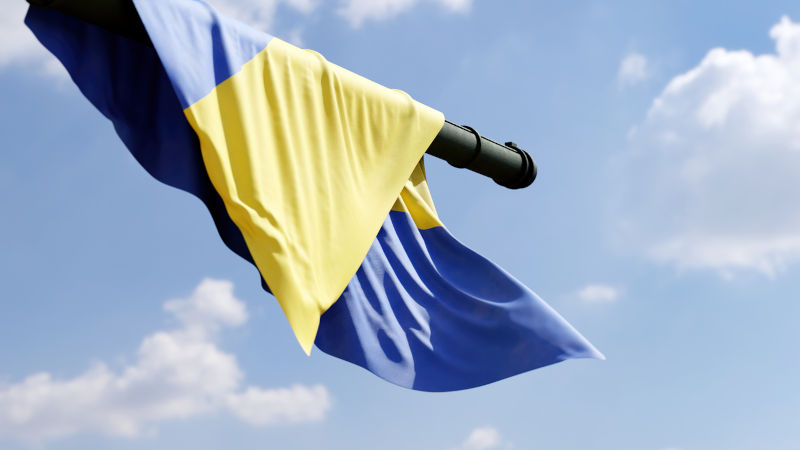Depleted Ukrainians
April 13, 2023
Fighting in Ukraine continues, sometimes fiercely, sometimes spasmodically. So do the unending appeals from Vladimir Zelensky for more and better weapons from the West. He is now to get from Britain anti-tank shells made from depleted uranium, which will increase radiation and chemical pollution where they are used.
Depleted uranium (DU), is basically the isotope 238, which is left after enriching natural uranium by increasing the concentration of the fissile isotope uranium-235. U-238 is fertile, not fissile. It cant cause a nuclear explosion, but has low but persistent levels of radio and chemical toxicity, and an extremely long half-life. It is denser than lead and harder than many forms of steel, and goes through armour plating like a knife through butter.
About 320 tonnes of DU munitions were used by the United States in the 1991 Gulf War; smaller amounts in Bosnia, Serbia and Kosovo in 1999; and against T-72 Russian tanks in Iraq in 2003. Now it is Ukraines turn.
The problem with U-238 munitions is environmental - they are pyrophoric and burn on impact, creating radioactive dust. This can be inhaled, settling in the nose, mouth, lungs and gut. The chemical toxicity of DU and its radioactivity reinforce each other in a so-called synergistic effect. During the Gulf War, Alexandra Miller of the US Armed Forces Radiobiology Research Institute found significant evidence of genetic damage in laboratory animals implanted with DU pellets. It depresses the immune system and is suspected of causing birth defects.
In 2004, the London School of Hygiene and Tropical Medicine found that mothers whose partners had served in the Gulf War had a 40 percent greater risk of suffering miscarriages than those who hadnt. In November 2009, The British Guardian quoted Dr Ayman Qais, director and senior specialist at the Fallujah General Hospital as saying, We are seeing a very significant increase in central nervous system anomalies there is also a marked increase in brain tumours. Iraqi boys playing in the dust with the remains of US rockets and anti-tank shells tended to sicken with respiratory and other diseases more frequently than those who did not.
Wide use of DU munitions in Ukraine could lead to similar public health problems there. It could also lead to nuclear escalation of the kind hinted at by President Putin. Russia could begin using DU ammunition of its own, possibly leading to the use of tactical nuclear weapons, something he has already threatened to do. No wonder the Doomsday Clock of the US Bulletin of Atomic Scientists now points to 90 seconds before midnight.
DU is not, of course, Ukraines only radiological hazard. First was the tragedy in northern Ukraine of the Chernobyl melt-down in April 1986, when a power surge caused a catastrophic graphite fire and explosion in reactor number 4. This resulted in a radioactive cloud blanketing Europe from Austria as far as Sweden and Finland, and the evacuation of 340,000 people from Belarus. Greenpeace estimated 90,000 resulting deaths in Europe. The nuclear industry claimed far fewer, but no one knows the exact number of fatalities.
Now we see the distinct possibility of a nuclear accident at the six-reactor plant at Zaporizhzhia. Based on the Dnieper River in the south of the country, it is the largest of four such complexes in Ukraine. It is also the largest nuclear power plant in Europe, generating 5,700 Mwe of electricity. It has been occupied by Russian forces since March 2022, controlled by the Russian nuclear organisation ROSATOM, and run under ROSATOMs supervision by its original Ukrainian operators.
Because of conflict in the area, all six reactors are at present in cold shutdown. But like the rest of the complex, they are endangered by occasional missile and artillery strikes against the plant. If power is cut off for any length of time, the fuel rods in the pressurised water reactors could over-heat and melt down, leading to a catastrophic explosion of hydrogen gas and release of huge amounts of radiation. The Western press absurdly blames the attacks on Russia - why on earth would Russian forces attack a complex it occupies? The attacks are almost certainly the work of Ukrainian para-military groups. A collection of 40-odd rightist fanatics launched a similar attack in May 2014 only prevented from occupying the plant and neighbouring town of Enerhodar by local Ukrainian police.
Meanwhile, Australia is one of the largest donors of military training and equipment to Ukraine outside Europe. Our leaders short-sightedly pride themselves on joining what is in effect a NATO war by proxy against Russia. A wiser and safer course would be for our usually intelligent foreign minister to do all she can to encourage the laying down of arms by both sides and the start of peace negotiations. She should also realise that Zelenskys demand that Russia vacate all territories it now occupies and return to Russia is quite unrealistic.
So far, only the Chinese have produced a concrete plan along such lines. It was released last February, and includes respect for sovereignty, abandoning a Cold War mentality, cessation of hostilities, resolution of a growing humanitarian crisis, protection of civilians and POWs on either side, and keeping nuclear plants safe. Good for the Chinese, but given current anti-Chinese attitudes among western powers, including Australia, their proposal has gained little traction or support. Can it possibly be acted on?
